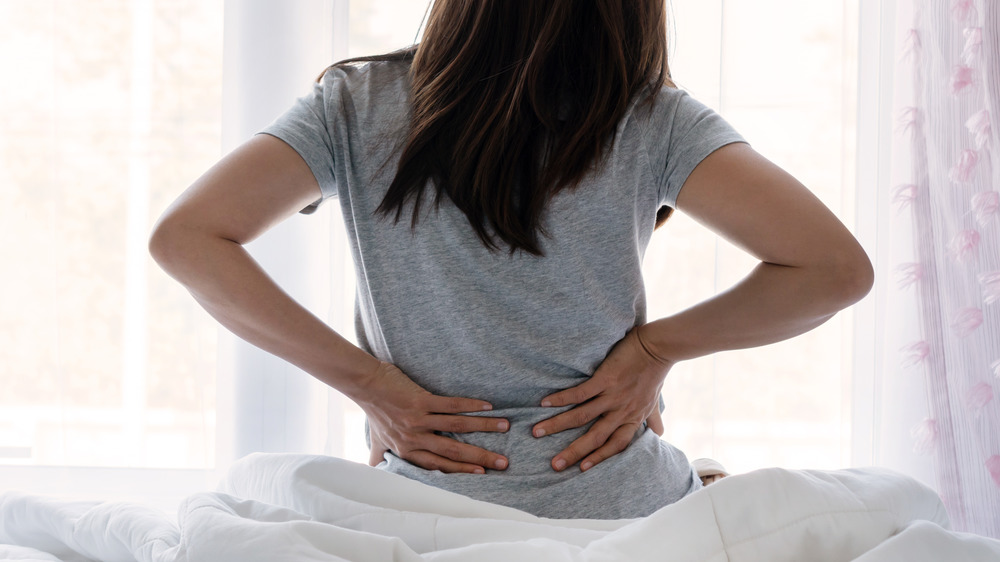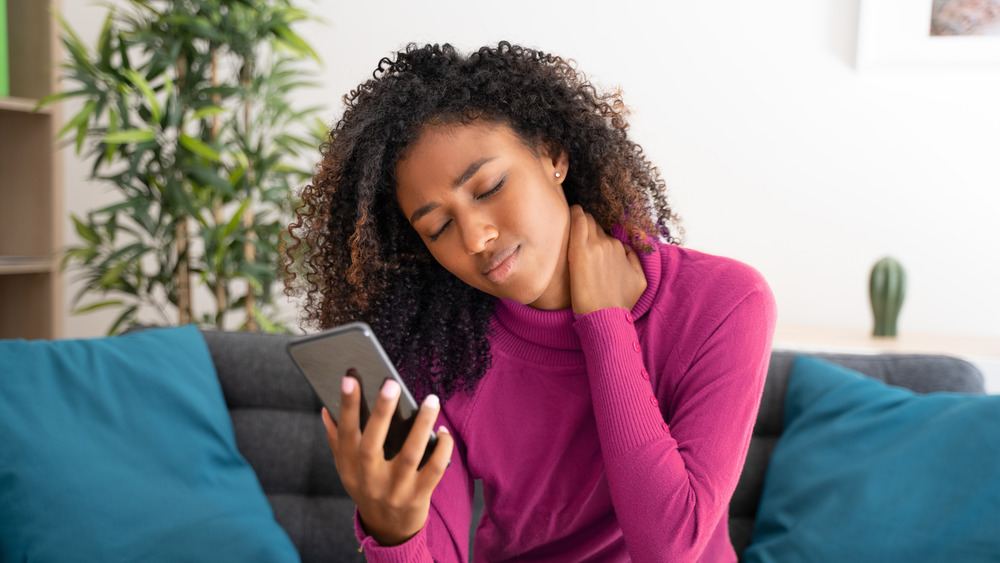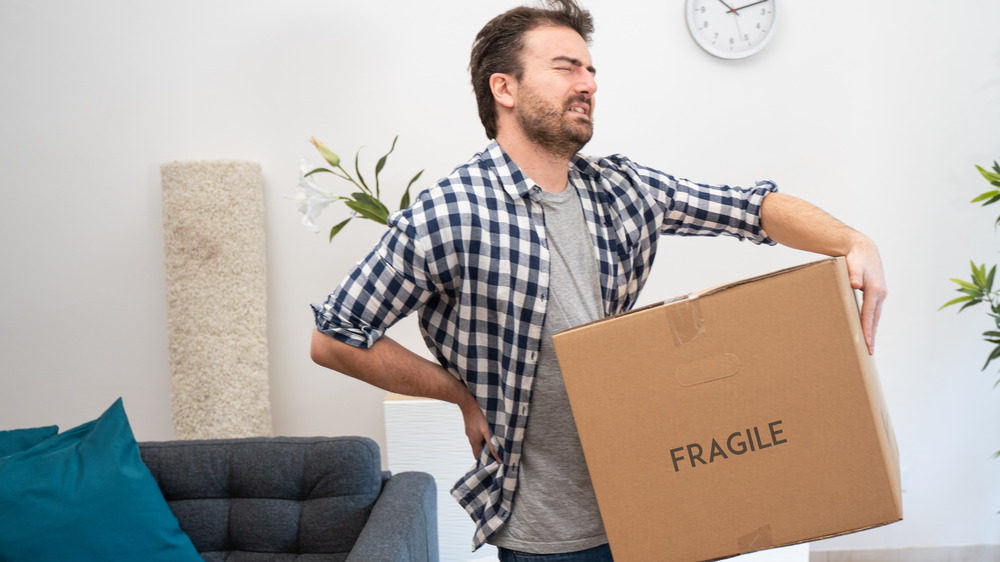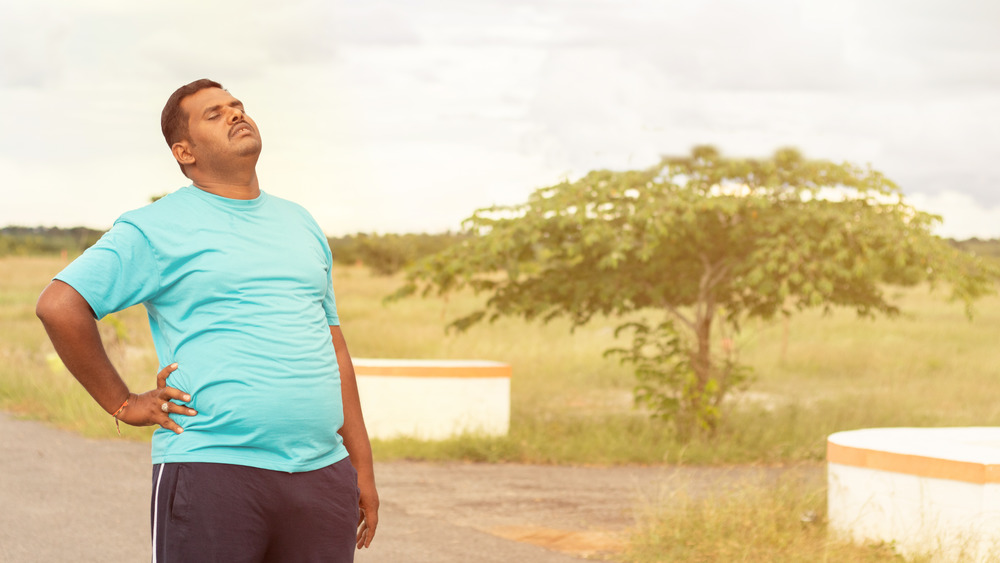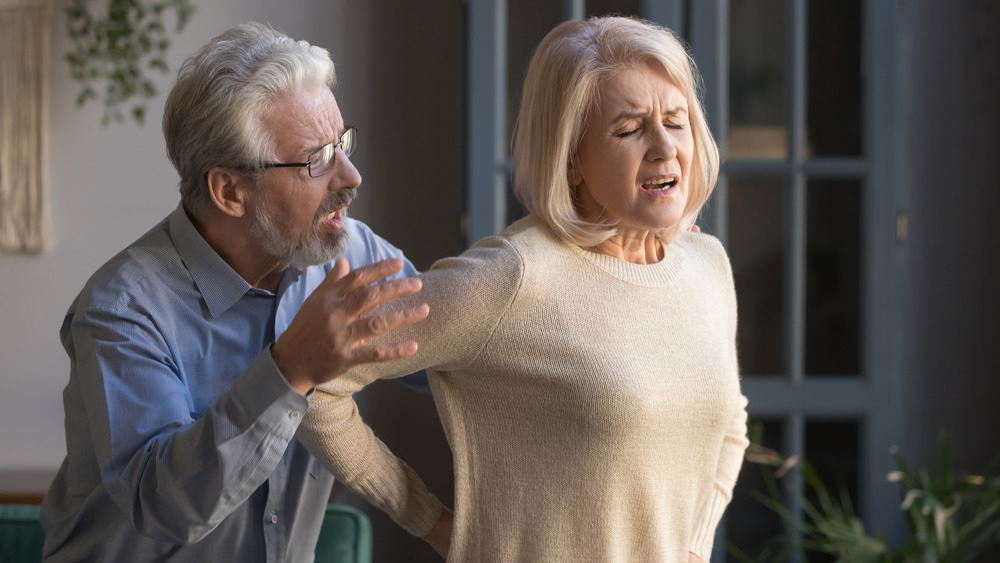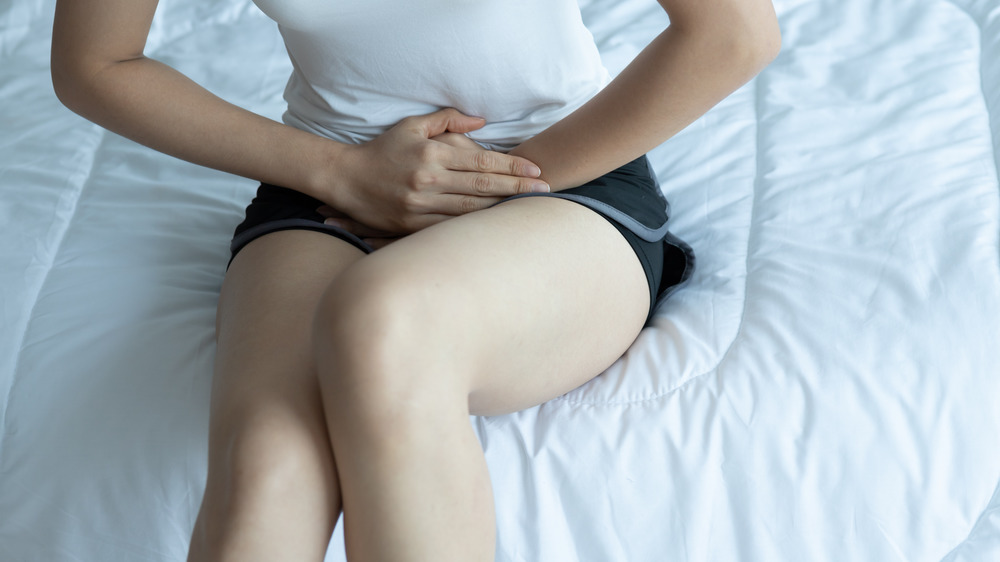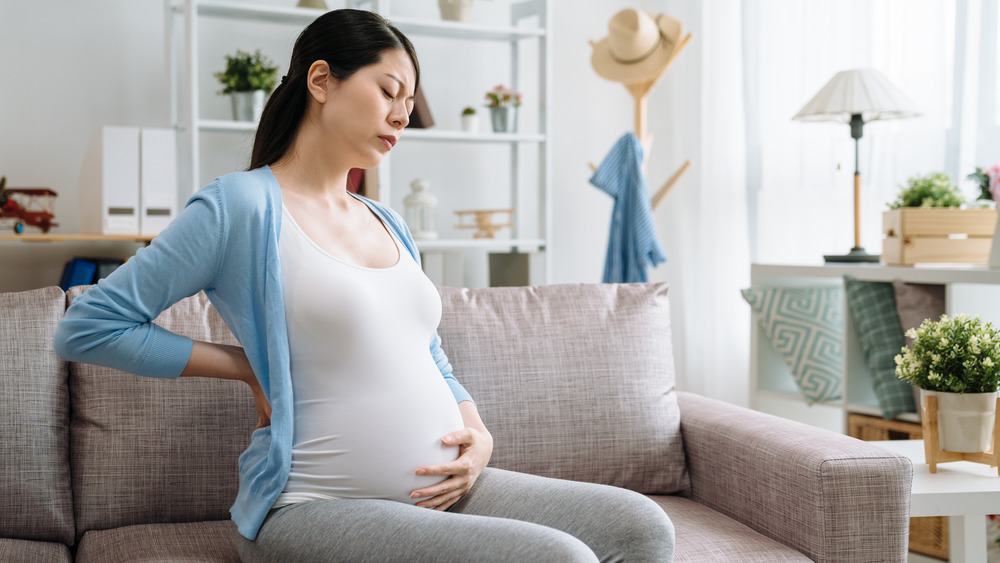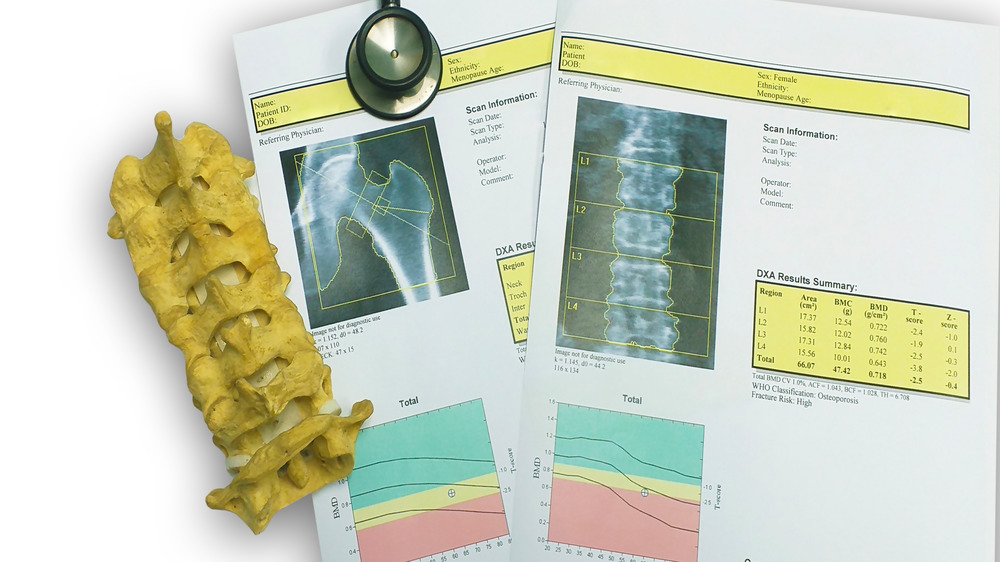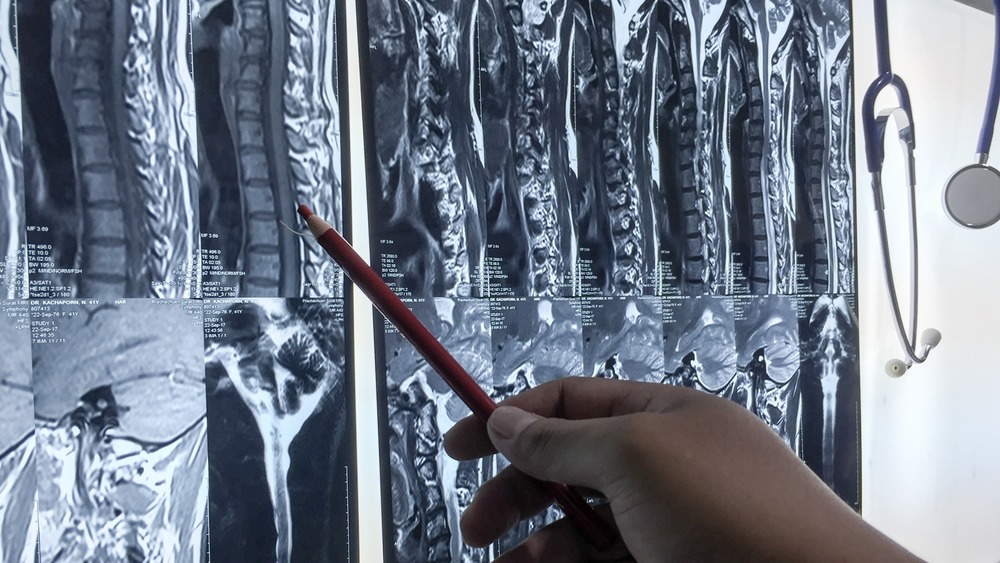If Your Back Hurts All The Time, This Is Probably Why
Back pain is unfortunately very common. According to the American Association of Neurologic Surgeons, roughly 75 to 85 percent of Americans will experience back pain in their lifetimes, but that doesn't make it any easier to deal with when the person laid up in bed all day is you. The good news is: Most back pain is temporary, and can be attributed to an acute event, like a strain or a muscle spasm you incur while picking up a heavy object with bad form. But it's important to identify and address the underlying cause, because in some cases, acute pain can lead to chronic pain if a minor issue isn't corrected.
Likewise, as summarized by the National Institutes of Health, some back pain can be degenerative (such as arthritis), congenital (such as scoliosis), related to an issue of the spinal cord (such as osteoporosis or an infection), or even can be attributed to issues that aren't directly related to the back itself (like kidney stones). If you don't know the root cause of the pain, it's much harder to effectively treat the problem and get back to feeling good. Here are some of the most common causes of back pain.
Tech neck may be the cause of your back pain
Your mom probably started telling you to stand up straight when you were a kid, and the advice holds true no matter your age. Bad posture and back pain often go hand in hand. Unfortunately, sedentary desk jobs and handheld technology, like cell phones, don't exactly help with maintaining good posture. Just think about it. When you find yourself engulfed in a text conversation with your best friend, how does your posture look? Chances are, you're rolling your shoulders forward, looking down at your phone, and "hunching" in a position that would irritate your mom.
This position actually has a name — cervical kyphosis, or "tech neck" — and according to the Spine Institute of North America, it places undo strain on your spine, causing tension in your neck and shoulders that can lead to upper back pain. If you find you're always caving to poor posture due to frequent technology use, you can combat the pain by positioning your screen higher to help prevent a forward tilt of your neck, using a chair with a headrest, moving around, stretching, and exercising on a regular basis (these actions help reinforce proper alignment and posture), and limiting your total use of technology.
Heavy lifting can aggravate your back
Muscle strains are an incredibly common cause of back pain that frequently result from performing everyday activities (via Healthline). Strains can be caused by a single event, like a sports injury, or they can develop over time with repetitive movements that place stress on the spine. Even actions as simple pulling weeds or picking up toys can cause a muscle strain. Bending, twisting, and lifting are common culprits because, after all, it's easy to forget about "lifting form" and using your abs to brace your spine when you're going through the motions of everyday life.
According to a Spine-health article written by Dr. Kojo Hamilton, a neurosurgeon, back strains (often termed a "pulled muscle"), can result in an achy pain that intensifies with movement and that may also cause difficulty walking or standing. Generally speaking, you can treat the pain at home by popping an over-the-counter anti-inflammatory or pain medicine, like acetaminophen, using ice packs to help reduce inflammation, and stretching, walking, and modifying activity to avoid actions that intensify pain, per Healthline. But if pain persists and is affecting your daily life, go ahead and get checked out by a doctor to make sure there's not a bigger, underlying problem.
Being overweight can put stress on your back
While researchers are still looking to pinpoint exactly why, a 2009 meta-analysis of 95 separate studies published in the American Journal of Epidemiology found a clear link between body mass index (BMI) and back pain. Individuals with "normal" BMIs were found to have the fewest incidences of low back pain, with incidences increasing for those falling within the "overweight" and "obese" categories, respectively.
This is likely due to the additional stress that added weight places on the bones, joints, tendons, and ligaments. But as Verywell Health pointed out, it may also be that added weight causes changes to biomechanics (how a person moves around), which could further lead to pain and problems at the spine. Think about it: If added weight makes it harder to walk with good posture and form, changes in the position of the feet and legs continue traveling up the kinetic chain, affecting movement at the pelvis and spine. Over time, this could cause serious damage. Your best bet? Make healthy lifestyle changes to try to keep your weight in a healthy range.
Not exercising enough can lead to back pain
If you're worried that exercise could cause back pain, guess what? Not exercising is likely a greater culprit. According to a 2019 study published in the Frontiers in Public Health, individuals who were sedentary were the most likely to experience back pain. Of course, this could be attributed to poor posture that affects muscle strength over time. It's important to note that regular exercise combats poor posture and helps strengthen the muscles of the legs, hips, and core that often become weakened from too much sitting. The same study found that vigorous physical activity was a protective factor for all forms of back pain.
The trick, of course, is to start an exercise program wisely. If you go from doing nothing to lifting heavy weights five times a week, you're likely to end up injured. Start slow — incorporate 20 to 30 minutes of moderate-intensity cardio activity, like walking or swimming, most days of the week (via Verywell Fit). Once you've developed a routine, add simple, full-body strength moves to your schedule two to three times a week. And if you don't know where to start, enlist a personal trainer to help you.
Sitting too much puts a lot of pressure on your spine
Look, even if you're a regular exerciser, there are real problems with staying in one position all day long. According to an interview with chiropractor Craig Banks for Insider, staying in one position — at your desk, on your couch, or in your bed — can place undo pressure on your spine, ultimately leading to pain. As Banks told the publication, "The discs between your vertebrae rely heavily on movement to get the nutrients they need and when they stay still for hours, it begins to aggravate the nerves around them."
Some sedentary activity can't be helped — a desk job is a desk job, after all. That said, you can plan ahead to help prevent sitting-related pain. For instance, set a timer on your phone to remind you to get up and walk around once an hour, or commit to standing up and pacing whenever you're on the phone. You can even see about setting walking meetings with your colleagues to talk about key issues while on the move. You may be surprised how much better you feel once you implement a few of these practices.
Smoking and back pain go hand in hand
Chances are you're well aware that a smoking habit isn't exactly good for your health. It's no secret that smokers have a higher risk for lung cancer and heart disease (via Healthline). What you may not realize is that smokers are also more likely to experience back pain, too.
According to a 2016 study published in Cureus, data from the 2012 National Health Interview Survey found that back pain was most prevalent in current smokers compared to former smokers or those who had never smoked. Interestingly, though, former smokers were also more likely to experience back pain than those who had never smoked.
While this study looked at the correlation between back pain and smoking rather than the causation, there appears to be a "dose-response relationship." In other words, the more frequently and more recently a person smokes, the more likely they are to have pain. Researchers who conducted the study point to several possible causes. For instance, nicotine might reduce pain threshold, and smoking may increase inflammation. Also, smoker's cough can't be overlooked, as a hacking cough can certainly cause muscle tightness and cramping in the back. Your best bet? Consider quitting smoking. It will only improve your health long term.
Depression and anxiety may be to blame for your back pain
This one may come as a surprise, but if you battle depression and anxiety you may find yourself battling back pain as well. When it comes to the relationship between mental health and back pain, the cause and effect is, well, complicated. As Dr. Srini Pilay, a psychiatrist and assistant professor at Harvard Medical School, wrote for Harvard Health Blog, pain or injury can contribute to psychological distress, which can cause greater levels of pain. In other words, you can find yourself in a cycle of pain and mental distress, where you may have to address both issues to find a way "out," so to speak.
And believe it or not, the experience of pain can actually change the wiring in your brain, creating links between pain and emotions, Pilay explained. So if you previously didn't have anxiety, experiencing an injury and its resulting pain could result in rewiring that triggers anxious feelings.
Of course, not everyone who has back pain will find themselves depressed or anxious, and not everyone who's depressed or anxious will end up with back pain. But if you find the two walking hand in hand, consider treating both with appropriate therapy, stress reduction techniques, or even hypnosis.
Your back pain might be a sign of spinal arthritis
It's an unfortunate fact that many people have arthritis, including spinal arthritis, as they age. According to Spine-health, this type of arthritis is often caused by the accumulation of stress, injuries, and general damage over time. Arthritis of the spine is common because the spinal joints responsible for twisting and bending are small, but the weight they're required to bear is generally large. Add to that the fact that muscle strains, sprains, or other injuries can damage the cartilage and discs that protect the spine, which, over time, can lead to the development of arthritis.
If your back pain seems greatest in the mornings, improves as you move around throughout the day, then seems to flare up at night or after remaining still for several hours, you just might be dealing with arthritis, according to Spine-health. If you suspect spinal arthritis, consider consulting your doctor and see about going or diagnostic tests, like x-rays or MRIs. With the right information your doctor can help you identify a plan of action for addressing the pain. While it's unlikely you can reverse arthritis once it starts, that doesn't mean you can't slow the damage or treat the pain.
Repetitive movements can lead to back pain
Diehard golfers may need to take a break — or enlist a coach and a chiropractor — if they're experiencing ongoing back pain. According to a Spine-health article written by Dr. Kojo Hamilton, a neurosurgeon, repetitive motions like swinging a golf club can contribute to chronic strain on the back given the force and repetition involved in these motions. And all the CrossFit athletes out there aren't immune either. Rowing, kipping pull-ups, and other exercises that require power, strength, and control can all be common culprits.
If your favorite pastime or your job requires you to constantly bend or twist, and if you find your back becoming sore or painful, you may need to take a break. Hamilton pointed out that repetitive motion injuries are particularly common when the muscle or joint is already sore or fatigued, and yet, the person continues to perform the motion.
That doesn't mean you need to nix your hobby completely — just be smart. Many injuries, including repetitive use injuries, can be attributed to poor form or weak abdominals that aren't sufficiently supporting the spine. In addition to taking a break, talk to a trainer or coach to have them check your form.
Is your back pain accompanied by fever? You might have sacroiliitis
If you're experiencing lower back pain at or around your sacrum — the part of the spine that meets your pelvis — you may be experiencing inflammation of the sacroiliac joint, or sacroiliitis. This is sometimes also referred to as sacroiliac joint dysfunction, although it's not quite the same thing, according to an article on Spine-health written by Dr. Amish Patel, an interventional pain management physician. Sacroiliitis refers to inflammation of the joint, while sacroiliac joint dysfunction refers to abnormal movement of the joint. But regardless of its cause or what you call it, pain in this region isn't fun, and it can contribute to hip and leg pain too.
Unlike most forms of back pain, the pain and discomfort associated with sacroiliitis may also be accompanied by a fever due to inflammation. This is why it's important to communicate with your doctor because sacroiliitis may arise due to infections, rheumatologic diseases like lupus, low back trauma, pregnancy, or even IV drug use. Usually sacroiliitis can be treated like other forms of low back pain — rest, over-the-counter medications, heat or cold therapy, and appropriate exercise — but in some cases additional treatment might be needed.
Your back pain could be due to a UTI or kidney infection
Infections of the kidneys or urinary tract often are accompanied by non-localized pain that radiates to the back. You may not even realize you have an infection if your other symptoms are mild, but you could still be experiencing this type of low- or mid-back pain. But because the pain isn't associated with a muscle or joint injury, the pain won't lessen with changes in position, Healthline highlighted.
The thing is, you don't want to mess around with bladder or kidney infections. In addition to other uncomfortable symptoms like frequent trips to the bathroom, pain or burning when urinating, feeling like you have to pee even if you can't go, and abdominal cramps, you could end up really sick. Kidney infections, in particular, can lead to fever, chills, nausea, and vomiting, and can even require hospitalization (via Healthline). If you're experiencing these symptoms, call your doctor or head to an urgent care clinic to get a diagnosis. You'll likely be prescribed antibiotics to help clear the infection, and your back pain will subside quickly after commencing treatment.
Pregnancy is a common cause of back pain
Oh, pregnancy. It's such a miracle, but often such a pain! It should come as no surprise that a woman's body goes through a multitude of changes as it grows a baby that ends up weighing anywhere from 6 and 10 pounds at birth, taking up a huge chunk of mama's abdomen. And as the baby grows, and as the mama's body releases hormones to help relax the joints to prepare for birth, while simultaneously gaining the weight necessary to sufficiently support this new little life, poor mom is set up for the perfect storm of back pain (via Mayo Clinic).
When Craig Banks, an Ohio-based chiropractor at Pinnacle Chiropractic spoke with Insider, he pointed to a number of pregnancy-related back pain causes, including hormones, the disproportionately added weight that can affect a mom's gait and movement patterns, and even the baby's position within the abdomen. After all, if the baby's head is pressing firmly on the sacrum, or if the baby loves to kick at the kidneys, chances are mom's not going to love the feeling. The good news is: Pregnancy doesn't last forever, and core exercises designed to strengthen and support your baby belly can help reduce pain (via Spine-health).
Back pain can be a sign of osteoporosis
While men and women are both susceptible to the age-related bone degeneration known as osteoporosis, women, in particular, face the risk at a younger age. While bone loss can begin in a person's 20s and 30s, women tend to see an increase during and following menopause, when hormone profiles change.
While you may be tempted to write off osteoporosis as no big deal, that's not a great stance to take. If you develop osteoporosis, your bones begin to thin. This thinning can take place in all of your bones, including your spine, as Verywell Health pointed. And a porous spine can lead to spinal fractures or "collapse" (doesn't sound very appealing, does it?) even from minor injuries. And guess what? A broken back hurts — a lot.
The thing about osteoporosis is that prevention is key. Regular exercise, including strength training or weight bearing exercises like walking, can help keep bones strong, while proper nutrition can help support bone remodeling and prevent excess bone loss, according to the International Osteoporosis Foundation. Also, ask your doctor about getting screened. A DXA scan is a non-invasive test that can give you a look at your current bone density.
Tumors can cause back pain
No one wants to think that their back pain might be related to a growth on or near the spine. Unfortunately, it does happen. In addition to tumors (cancerous or benign) that can grow on the spinal column itself, tumors growing in other organs that place pressure on the spine can also lead to pain. For instance, kidney tumors or lung tumors can be the cause of back pain in the associated regions.
According to the Mayo Clinic, common symptoms of a spinal tumor include pain at the tumor site, general back pain that radiates elsewhere, and pain that worsens at night. Other symptoms — reduced sensitivity to heat or cold, incontinence, difficulty walking, and loss of sensation or muscle weakness — can indicate that the nerves are being affected.
The thing is, though, there are lots of causes of back pain, and many back pain symptoms can be attributed to problems other than tumors. If your pain is persistent and progressive and there's no other obvious cause, schedule an appointment with your doctor.

